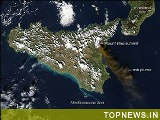Analyses give clues to composition of volcanic ash used in ancient Maya pottery
 Washington, Oct 9 : Scientists have obtained geochemical clues about the composition of volcanic ash used in Maya pottery between the 7th and 10th centuries, which could also help them determine where potters obtained their raw materials.
Washington, Oct 9 : Scientists have obtained geochemical clues about the composition of volcanic ash used in Maya pottery between the 7th and 10th centuries, which could also help them determine where potters obtained their raw materials.
Researchers have long known that Maya of the Late Classic period, an archaeological interval that stretched approximately from 600 to 900, used a mixture of volcanic ash and clay to make pottery.
Microscopic analyses of broken potsherds show that the ash particles are sharp-edged, indicating they were freshly erupted when the pots were made, according to Brianne Catlin, a geoarchaeologist now at Hess Corp. in Houston.
While at the University of California, Santa Barbara, she and her colleagues analyzed pottery fragments found at El Pilar, a Maya site near the Belize-Guatemala border, in an attempt to find the source of the pottery’s ash.
Very little soil covers the carbonate bedrock at El Pilar, and all of the ash layers found there are too old and chemically degraded to have supplied the ash used in the pottery.
Because the Maya pottery typically is both heavy and fragile, it’s unlikely that such items were imported.
Instead, Catlin speculates that ash was hauled in for local potters from other areas at great effort — especially considering the Maya had no roads, no pack animals and would have needed to import several tons of the material each year to produce enough everyday dishes and pottery for the site’s thousands of residents.
To see how various combinations of temperature and heating times affected the chemical composition of ash in pottery, Catlin and her colleagues fired pots using a 50-50 mixture of clay from the El Pilar site and volcanic ash of known chemical composition from California.
In the tests, for example, the longer the pottery was fired, the more sodium was driven from the material.
The hotter the firing temperature, the higher the calcium concentration became. Finally, the firing process didn’t affect the silica content of the pottery at all.
The ash in the potsherds found at El Pilar is about 78 percent silica, the researchers found.
That’s distinctly different than the composition of ash from El Chichon volcano, which lies about 375 kilometers west of El Pilar and spews ash that’s about 58 percent silica.
Catlin and her colleagues are now analyzing ash from several volcanoes that lie between 350 and 400 kilometers southwest of El Pilar, to see if material spewed from those peaks has a chemical composition that matches the ash used in the Maya pottery.
The team’s tests suggest that besides being about 78 percent silica, that ash probably had a 0.4 percent concentration of calcium. (ANI)